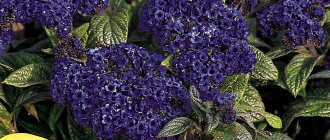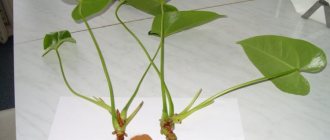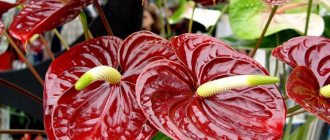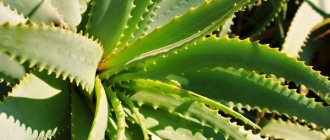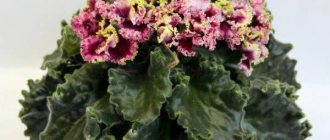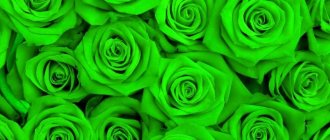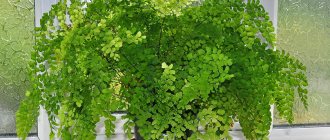Growing this plant since the second half of the twentieth century, breeders have developed various new hybrid varieties. New varieties of flowers differ in color and shape from the original plant.
Anthurium Andre is native to Ecuador, southern Colombia.
It can grow in the tropical part, on the slopes of rocky mountains; some specimens sometimes grow at an altitude of two thousand meters.
Description of Anthurium
Anthurium Andre or Anthurium Andrianum are evergreen plants of the Araceae family. There are many varieties of them, approximately 900.
They have leathery foliage and come in different shapes.
The flowers are collected into a spadix. The cob has a leaf-veil. The bedspread comes in different colors and is heart-shaped . Attention! The plant requires quite careful care, it is difficult to grow at home; some types of flowers can only be grown in heated greenhouses.
Why did the flower receive a specific nickname?
As already mentioned, for girls seeking to find family happiness, this flower helps in attracting male energy into the house. It is believed that blooming anthurium is a guarantee of a happy and harmonious life for spouses. Some especially impressionable people believe that the plant can even help with the problem of alcohol abuse and get rid of the addiction.
Why did “male happiness” get its popular name? It's all about the form. A pistil sticks out in the center of the opened heart-shaped bud, reminiscent of the moment of manifestation of male power. Anthurium flowers symbolize potency, power, masculine strength and performance.
It is believed that it is during the flowering period that the plant reaches the peak of its magical abilities. At this time, it actively attracts good luck, joy, happiness, love into the house, helps to restore the brightness of the colors of the world and the taste for life and realize the plans.
Types and varieties with names and photos
Favorite
The plant is tall and has leathery foliage. The flowers have a pinkish veil, maybe salmon-colored. And the corolla is pale violet-red, it has a pink tip.
Silence
The bract is snow-white or pale cream, and the inflorescences are pale yellow. This houseplant has broad, dark green foliage.
The flower
cannot withstand strong light .
Leganza
The plant has oval foliage with pointed tips. The flowers are bright orange or yellow.
The bract is pinkish or coral in color, but with a green border.
Adrios Red
Has a scarlet coverlet.
Otazu
It has a bright yellow inflorescence and a dark red bract.
Champion
It has large leaves. And the bract is pinkish or snow-white.
Belize
The plant has an intense yellow inflorescence and a dark red bract with a greenish border.
Mix
This is a hybrid bred by crossing various varieties of anthurium.
Arizona
The plant has scarlet bracts and yellow inflorescences.
Florida
The plant has reddish-orange bracts that are green at the end.
Polaris
It has white-green bracts.
Minnesota
The bracts are scarlet, have a yellow border, and yellow inflorescences.
Acropolis
The bracts are snow-white.
Lunette
The bracts are soft pink, and the inflorescences are a deeper shade of pink.
Sensa
The bracts are purple and the inflorescences are dark purple.
Decorative flowering types of anthurium
There are over 500 varieties of anthurium in nature. There are about thirty species of them in indoor floriculture. Of the decorative flowering ones, two species are most often grown at home - Andre's anthurium and Scherzer's anthurium.
Anthurium Andre
Anthurium Andre
Anthurium Andre is an ornamental flowering plant - an epiphyte. It reaches a height of 1 meter. The stem is shortened, the root system is well developed. The leaves are dark green, leathery, oblong, on high petioles. They reach a length of 40 cm and a width of 20 cm. The peduncle is usually longer than the leaf petioles. There are many aerial roots on the shoot. The peduncle can be up to 15 cm long, the flower spathe is heart-shaped, glossy, with a metallic sheen, reaches 20 cm in length, and almost the same in width, 18 cm. It is also leathery, crinkled, bending towards the bottom. Often the bedspread is bubbly with clearly visible veins on it. The color of the bedspread ranges from white to bright red. The cob is up to 15 cm long and has a white or yellow color. Anthurium Andre does not have a pronounced dormant period. It blooms all summer, and with sufficient watering and good light it can bloom all year round. Moreover, adult plants bloom more abundantly than young ones, and only at home.
This may be interesting: Care for Medinilla at home
Anthurium Scherzer
Anthurium Scherzer
The main difference between this anthurium and the others is its small size and unusual cob. An unusual inflorescence is formed on a peduncle, sometimes reaching 50 cm in height . It is an elongated, spirally twisted spadix of orange-red color, up to 8 cm long. The spathe surrounding the inflorescence is usually thick, almost round in shape, and bright orange. As we have already written, Scherzer’s anthurium stands out from the rest with its miniature size - it grows no higher than 30 cm. The stem is green, short, up to 15 cm in height, but thick, up to 2 cm in diameter. Anthurium Scherzer has magnificent leaves: leathery, pubescent on both sides, dark green in color, oblong with a pointed end. The leaves are up to 26 cm long and up to 6 cm wide. The petioles are shorter than the leaves. Imagine that up to 8 flowers bloom at once in a flower pot, and they last an amazingly long time - up to three months! The flowers exude a pleasant aroma.
Anthurium Scherzer is an unpretentious flower to care for at home, so breeders are developing more and more new varieties of this elegant flower. They learned to produce variegated varieties, speckled and twisted in a spiral with several curls.
Based on the color of the veil of Scherzer anthurium flowers, three groups of varieties can be distinguished: red anthurium, green anthurium and pink anthurium.
Anthurium Red
We can recommend Anthurium Red to novice gardeners. It blooms for several months. Its bright red, magnificent flowers will lift your spirits, and if you follow the basic rules of caring for it, anthurium will delight you with its beauty all year round.
Another anthurium that is very popular among gardeners is Amaretti. You will recognize it by its white inflorescence with red spots. His bedspread is multi-colored, combining red, orange, yellow and green colors. This is a new variety, but has already gained popularity for the beauty and duration of its magnificent flowering.
Anthurium Amaretti
All indoor anthuriums are perennial plants. Breeders have developed many varieties of flowering anthuriums with purple, burgundy, white and even black flower covers. But the most common color is bright red. The smell of anthuriums of different varieties is also different, but all of them have a pleasant smell.
This may be interesting: Muraya - growing from seeds at home
Transfer
Prepare a new pot with drainage holes and fill it with soil.
Before transplanting, water the flower thoroughly, then the soil will be softer and the root will be easier to remove from the container. If you have a plastic pot, you can lightly tap it on something hard.
Afterwards, the anthurium is removed, inspected and placed in a new pot.
Important! Replanting is required if roots are visible from the drainage holes and on the soil surface. It is better to choose a pot that has the same height and diameter.
If you transplant a flower into a pot that is too spacious, you will wait a very long time for the anthurium to bloom, since it will not form flower buds until the roots grow into the new soil.
After transplanting, the flower is watered again, and sphagnum moss is sprinkled on top.
Homeland and history of the plant
The tropics of America and the Caribbean islands are considered the homeland of this plant.
The flower got its name from 2 Greek words “anthos” - flower, “oura” - tail.
The flower was discovered at the end of the 19th century by a botanist from France, Edouard Andre, during a study of plants in Colombia in the Andes mountains. He was looking for plants of the Orchid and Aroid species, which he sent to Europe.
As a result, in Belgium, Jean Linden acquired the first flower for cultivation and resale.
Home care
Lighting
Anthuriums require diffused lighting; the flowers tolerate partial shade well. Therefore, they need to be shaded from the sun's rays. Window sills in the east and northwest are perfect.
Temperature
In summer, the optimal air temperature for them is +20-28°C, but not lower than 18°C. And from the beginning of autumn to February, a temperature of +15-16°C is suitable for them.
But one variety of anthurium requires lower temperatures, the plants are called Scherzer anthurium hybrids. And in winter they are kept for 6-8 weeks at an air temperature of +12-16°C, during which time watering is reduced.
If you need the plant to bloom earlier, then in January the temperature is gradually increased to +20-25°C.
Watering
Water the flowers abundantly, but make an interval between waterings and wait for the top layer of soil to dry. But it is impossible for the lower layers of the earth to dry out.
Important! The flower is watered approximately once every 4 days with soft water at room temperature.
In order for the anthurium to bloom in winter, at the beginning of autumn, watering is gradually reduced, the relative air humidity should be 80-85%, and the air temperature +16-18°C.
Water the flowers with soft rainwater . If you water with tap water and lime, soften it.
Do not over-moisten the soil, as the plant's roots may rot. Also, do not allow the water in the pan to stagnate. After watering, immediately pour out excess water from the pan.
Soil and fertilizers
Make a substrate by mixing 2 parts humus, 1 part leaf soil, 1 part peat soil and 0.5 sand. Next, 15% of cones, charcoal, and sphagnum moss are added to the substrate to give the soil greater lightness and breathability. Anthurium requires slightly acidic soil with pH = 5.5-6.5.
Another substrate option is to mix equal parts of soil for flowers and special soil for orchids.
And also add sphagnum moss.
A mixture of sphagnum moss, peat soil and coconut fiber works well.
From the beginning of spring to the end of summer, anthurium is fertilized once every 2 weeks. First, in the spring, a weak solution for decorative deciduous plants is used for feeding, and after 2-3 such feedings they switch to others: Agprikola, Fertika-lux.
especially need fertilizing before the buds open . In winter, the plant is stopped fertilizing.
Possible difficulties
If you notice:
- spots on stems and foliage;
- wilted foliage;
- the plant does not bloom, its growth is slow.
This can happen due to excess moisture, improper soil composition, insufficient soil breathability, diseases or pests.
You need to water the plant and remove it from the pot. Remove the old soil, carefully examine the roots; if they are damaged or have begun to rot, then cut off the rotten areas and treat the wounds with charcoal powder.
Also inspect the stem and leaves, remove dried or yellowed leaves, cut off inflorescences and flower stalks. If signs of rot are visible on the plant, treat the flower with a fungicide.
Plant the plant in new soil and a new pot.
This video contains detailed and valuable tips on how to avoid possible problems with growing anthurium:
Why doesn't it bloom
- To flower, the plant must be kept in a room with a temperature of at least +18°C.
- The flower should not be placed in direct sunlight. The flower really does not like drafts.
- It is necessary that the volume of the pot be slightly larger than the volume of the roots, otherwise the plant will not bloom.
- Don't forget to fertilize the plant.
Diseases and pests of anthurium
Diseases
Due to the fact that liquid regularly stagnates in the substrate, rot may appear on the roots of the anthurium. Remember that you need to moisten the substrate only when it has dried at least 1/3 deep, especially if the room is cool.
Flower growers quite often encounter drying of anthurium leaf plates, and they begin to dry from the edges.
Possible problems
- Lack of flowering . This may be due to disease or the presence of pests. And the bush may not bloom due to improper care.
- Yellowing of foliage . If the leaf plates begin to change their color to yellow, this indicates that rot has appeared on the root system. To save the flower, you need to act quickly. Remove the bush from the pot and remove the substrate from the roots. Trim off all rotten parts of the bush, after which it is planted in a new soil mixture. Adjust the watering regime to prevent moisture stagnation in the roots.
- The tips of the leaf blades turn black . The substrate contains a lot of calcium. Remember that during feeding, the dosage of mineral fertilizer must be reduced exactly by half.
- Specks on the foliage . They are formed due to excessive watering.
- The plant began to dry out . This may be due to either a deficiency or an excess of minerals in the substrate. Also, this problem may be associated with poor or too much watering. Sometimes the problem can be solved by completely replacing the substrate.
- Twisting sheet plates . This can happen for a variety of reasons: exposure to direct sunlight, drafts, poor lighting, or too dry air.
Anthurium is blooming like crazy! Transplant and Care! ANTHURIUM DOES NOT BLOW, THE LEAVES TURN YELLOW AND DRY!
Pests
Spider mites and aphids can settle on the plant, but most often scale insects appear on it.
What does a flower bring to the house, male happiness: signs and superstitions
According to signs, anthurium:
- Increases income, brings financial well-being;
- If a husband has offended his wife, the wife should put his thing near the anthurium - the husband will be ashamed;
- Anthurium flowering out of season means husband’s betrayal;
- If the anthurium “cries” (drops of water appear on its leaves), it means that the spouses no longer love each other;
- If it withers, it means that the man of the family will soon fall ill;
- Rotting roots mean a secret enemy;
- If it has dried up, it means that the man is not respected here;
- Attracts prosperity, happiness, success, a strong, happy marriage.
- The leaves have turned yellow, which means that the couple will soon quarrel.
Also, according to popular belief, anthurium helps men in everything. The proximity of this flower will supposedly help a man quit smoking, strengthen potency, become more successful at work, become calmer and happier. Anthurium helps women become sexier, richer and attract the desired man.
Reproduction
In this section we will tell you how to plant anthurium. There are three ways to do this.
Dividing the bush
Cut off a leaf from an adult plant. The cut is made with a sharp knife, and the cut area is sprinkled with crushed coal. Then transplant the leaf into another pot. You need to water carefully, do not overdo it: excess moisture will have a bad effect on your green pet.
By cuttings
To do this, you need to cut off part of the stem; it is important that it contains all the necessary parts of the future adult flower: an aerial root and a leaf. You plant this cutting in another pot, it quickly germinates, takes root, and begins to develop.
Seeds
The most difficult way. What should be done:
- Pollinate the flower. To do this, run a brush or cotton swab over the ear of flowers, and then transfer the collected pollen to another ear - this is called artificial pollination. This must be done in the very first days of flowering, preferably several times, to be sure.
- If you did everything correctly, the cob will then form berries instead of flowers, and the berries will contain seeds. They will ripen in eight months. The seeds need to be pulled out, washed and dipped in a weak solution of potassium permanganate.
- Then lower the seeds into the soil. There is no need to dig in, just press down a little. Make a greenhouse out of the pot (cover it with cling film or glass) so that there is always high temperature and humidity. The seeds will sprout in two to three weeks, you will see the first flowers in two years, and the flower will fully bloom in four years.
- Flowers are transplanted into a larger container when the first two leaves appear. The soil in a large pot should be fertile: with cow manure, peat, coal. This procedure is carried out a couple more times before the plant reaches its full size.

